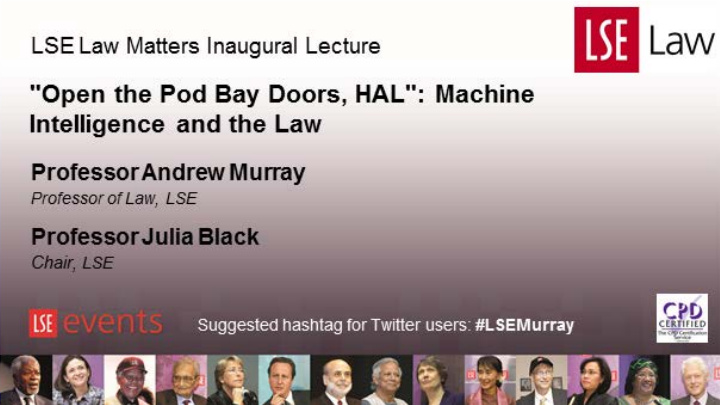



LSE Law Matters Inaugural Lecture "Open the Pod Bay Doors, HAL": Machine Intelligence and the Law Professor Andrew Murray Professor of Law, LSE Professor Julia Black Chair, LSE Suggested hashtag for Twitter users: #LSEMurray
Open the Pod Bay Doors HAL: Machine Intelligence and the Law Professor Andrew Murray
Part I
Humans are “ meat” machines
The Dress
Higher/ Lower Order Thought S ystem I and S ystem II Multiply 12x6 Multiply 16 x 47 Multiply 417 x 514
Outsourcing S ystem 2 Brains at the Ready Brains at the Ready II S martphones Allowed… . Who won the 2014 Eurovision S ong Contest? Who won the 1972 Eurovision S ong Contest? Vicky Leandros (Representing Luxembourg) Après Toi Conchita Wurst
Assisted Decision-Making Click here for the relevant video
S upplementary Decision-Making Click here for the relevant video
Autonomous Decision-Making Click here for the relevant video
Part II
How Machines Think (or Don’ t) Machines (currently) don’ t think they process.
Law for Machines? Handbook of Robotics, 56th Edition, 2058 A.D 0. A robot may not harm humanity, or, by inaction, allow humanity to come to harm. 1. A robot may not inj ure a human being or, through inaction, allow a human being to come to harm. 2. A robot must obey the orders given it by human beings except where such orders would conflict with the First Law. 3. A robot must protect its own existence as long as such protection does not conflict with the First or S econd Laws
The Moral Maze The trolley problem
Open the Pod Bay Doors HAL Click here for the relevant video Is HAL morally or legally wrong?
That’s S cience Fiction Right?
Watson
Taranis Click here for the relevant video
S mart Agents and S afety Physician Heal Thyself Driver’s Ed. Fatal Air Accidents Cause 1950s 1960s Prevalence 1970s 1980s Human Error 1990s 2000s All Human Factors Environment Vehicle Human Only Human Error Anaesthesia 61% 0.0365% 63% 53% 52% 82% 63% 63% 59% Tri-Level (1979) 93% 34% 13% N/ A S Weather urgeon Action 15% 0.9% 12% 14% 14% 58-79% 8% 6% 12% Overall Mortality 1.85% 29-37% Mechanical 19% 19% 20% 21% 18% 22% 20% TRRL (1980) 95% 28% 8.5% 65% Failure Preventable Adverse Effects (US Data) 210,000 deaths per annum Sabotage/Others 5% 6% 13% 13% 11% 9% 9% IAM (2009) >90% 15% 1.9% N/ A NHTS A (2015) 94% 2% 2% N/ A
A Quick Recap 1. Humans remain uniquely the only source of the form of higher order sentience that allows us to make complex moral decisions. 2. Humans, perhaps uniquely in the animal world, can rationalise obj ective and subj ective thought. 3. Human brains are complex, but also are resource hungry and as a result we often rej ect resource heavy higher-order thought for lower level intuitive thought. 4. Humans have a capacity to outsource anything complex, difficult, dangerous or time consuming. 5. We are developing machines which are capable of complex thought and creativity. 6. We are developing machines designed to act autonomously. 7. Human Level Machine Intelligence could be as little as 14 years away (or as far away as 75 years). 8. It is perfectly logical to suggest that there should be an assumption that machines should replace humans in all areas where human error remains a constituent factor in harmful outcomes.
S entience in the Law
S entience in Punishment
The Challenge of Machine S entience A new legal concept: Obj ective Personality? Obj ective Expression Obj ective Location Obj ective Privacy Obj ective Consent Obj ective Mens Rea?
The Lawmaker’s Dilemma Fail to Recognise Recognise Machine Machine Sentience Sentience Gives Aut onomy t o Creat e Permanent Man-made (Art ificial) Underclass Devices Fail t o Recognise Could Remove Change in Human Responsibilit y from Thought Human Agent s Ent ire Legal A Modern S lave? Framework Needs Updat ing
The Lawmaker’s S olution? Lex Machina Ambient Law Legal/ Code Hybrid for both Humans and AIs (Asimov’s) Fourth and Fifth Laws • A robot must establish its identity as a robot in all cases. “ Code is Law” • A robot must know it is a robot.
Lex Machina ’s Normative Values (from Asimov ) 1. A self-aware being (human or robot) may not harm any class of self-aware beings, or, by inaction, allow any class of self-aware beings to come to harm. 1. A self-aware being (human or robot) may not injure a self-aware being or, through inaction, allow a self-aware being to come to harm. 1. A self-aware being (human or robot) must obey the Law except where such provisions would conflict with the First and Second Values. 1. A robot should protect its own existence as long as such protection does not conflict with the First, Second or Third Values. 1. A robot must know it is a robot. A human must know they are human. 1. A robot must establish its identity as a robot in all cases. A human must establish its identity as a human in all cases.
LSE Law Matters Inaugural Lecture "Open the Pod Bay Doors, HAL": Machine Intelligence and the Law Professor Andrew Murray Professor of Law, LSE Professor Julia Black Chair, LSE Suggested hashtag for Twitter users: #LSEMurray
Recommend
More recommend